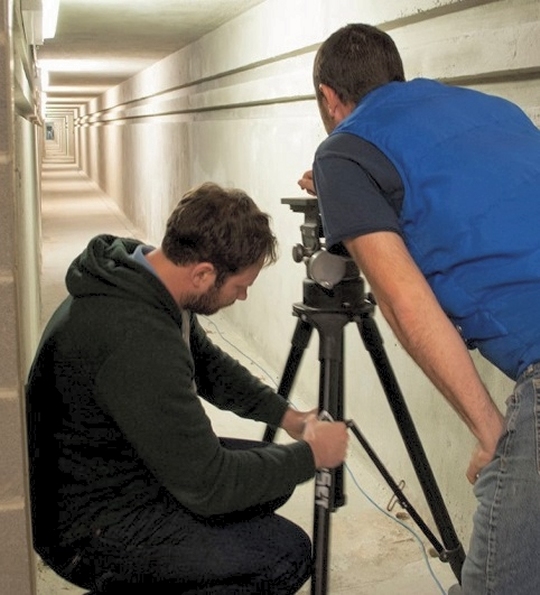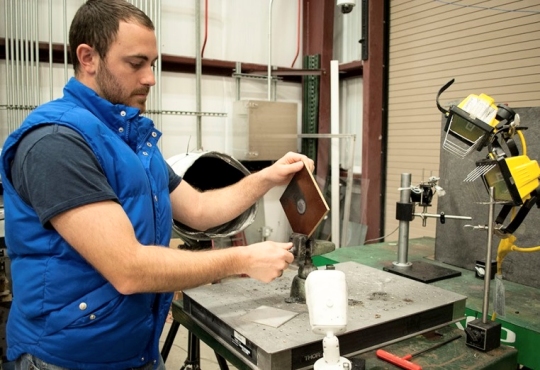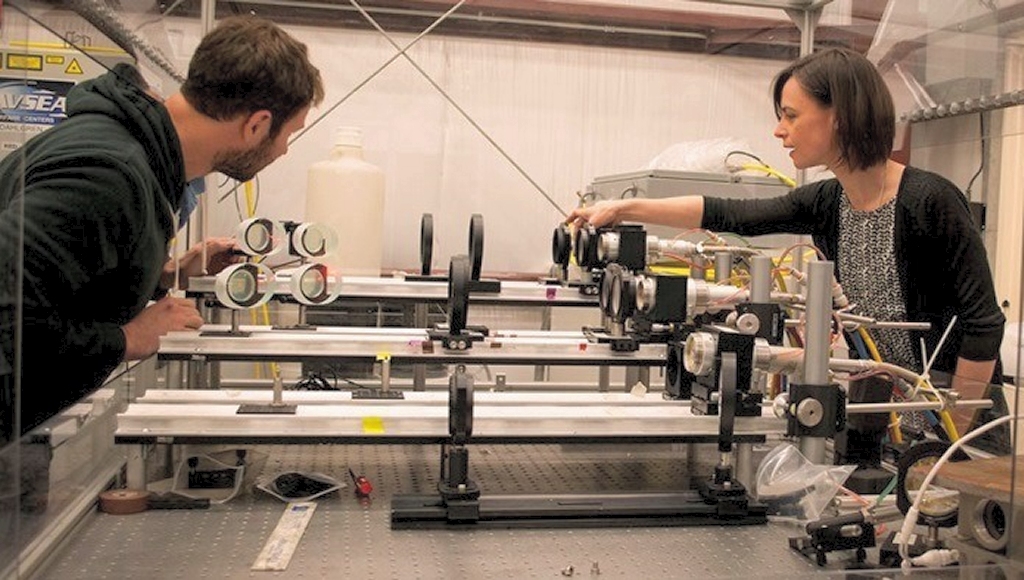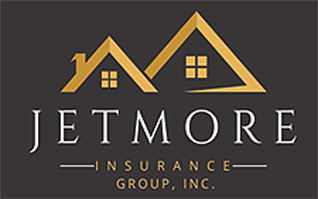 DAHLGREN, Va. - Naval Surface Warfare Center Dahlgren Division (NSWCDD) scientists prepare for a lethality test in the Navy's Laser Lethality and Development Laboratory's 100 meter long, above ground tunnel. The tunnel—crucial to gun range operations during World War II—was recently transformed into a vital new capability for testing laser technologies, NSWCDD officials announced April 21.
DAHLGREN, Va. - Naval Surface Warfare Center Dahlgren Division (NSWCDD) scientists prepare for a lethality test in the Navy's Laser Lethality and Development Laboratory's 100 meter long, above ground tunnel. The tunnel—crucial to gun range operations during World War II—was recently transformed into a vital new capability for testing laser technologies, NSWCDD officials announced April 21.DAHLGREN, Va. (, 2017)—The Navy's top laser experts transformed a tunnel crucial to gun range operations during World War II into a vital new capability for testing laser technologies, Naval Surface Warfare Center Dahlgren Division (NSWCDD) announced April 21.
For years, civilian scientists—including those who developed and installed the Laser Weapon System aboard USS PONCE (AFSB[I] 15)—speculated about the long dormant 100-meter tunnel and its potential for laser lethality and system testing.
Could it be converted to research, test, develop, and evaluate a new generation of laser weapon systems for integration aboard warships?
Eventually, their question was answered and the old tunnel was upgraded. Now, it's integral to the Navy's state-of-the-art Laser Lethality and Development Laboratory.
"Our scientists and engineers are taking advantage of the Laser Lethality and Development Lab's capabilities—including the above-ground tunnel—to innovate and evaluate high energy lasers that are interoperable with Navy ships and electric weaponry," said CAPT Godfrey 'Gus' Weekes, NSWCDD commanding officer. "As we continue to develop and deploy laser weapons to the Fleet with the inherent advantages of directed energy—speed-of-light delivery, engagement precision, magazine depth, and scalable effects—our warfighters will have significant technological advantage over our adversaries."
Navy leaders have made directed-energy weapons a top priority to counter asymmetric threats. In fact, Navy Sailors—trained by the NSWCDD Laser Weapon System team—proved how precise and effective a High Energy Laser weapon system can be during testing in the Arabian Gulf against small attack boats, unmanned aerial vehicles, and other moving targets in various weather conditions.
Meanwhile, the laser experts are using the Laser Lethality and Development Facility's capabilities to support emerging initiatives to integrate future laser weapon systems aboard Navy ships. The facility features two labs where high power laser testing of materials, components, and sub-systems are conducted. The labs are connected by the above-ground tunnel which provides for the safe conduct of indoor testing at significant ranges while removing the effects and limitations of the highly variable outdoor environment.
"The facility, which is unique within the Navy, along with its suite of analysis tools are essential for designing, developing, and integrating laser technology into existing and future fighting forces and platforms," said Frank Dixon, NSWCDD Directed Energy and Pulsed Power Division head.
The lab—primarily dedicated to performing laser effects testing—supports programs sponsored by the Office of Naval Research, Joint Directed Energy Transition Office, and Program Executive Office for Integrated Warfare Systems, among others. The testing determines environmental effects on laser performance, the response of target materials to laser energy, and provides input to the characterization of laser weapon system requirements.
"A capability such as this allows us to stay in front of high energy laser weapon lethality testing and modeling and simulation to support the current and growing number of Navy laser weapon programs", said Dr. Christopher Lloyd, NSWCDD's High Energy Laser Lethality lead.
"We'll be able to expand the tunnel's range further—up to 300 meters—with some unique test configurations," said Lloyd. "It will soon enable testing in controlled environmental conditions to better replicate weather conditions in regions where deployed high energy laser systems may operate. We'll be able to study aspects such as beam propagation effects from turbulence and scattering/absorption and how that affects overall system performance."
Currently, the laboratory's roof-top platform allows for operation and testing of laser systems across the Potomac River Test Range where naval guns have been tested since 1918. From this platform, high energy laser operations can be conducted over to the Combined Experimental Test Facility, a two story laser backstop located two to three kilometers across the water.
"The facility—coupled with our indoor and outdoor laser test capabilities—enhances the command's ability to design, develop, test, and integrate next generation laser weapon systems for the Navy and is critical to the transition of these systems to the Fleet," explained Dixon.
Environmental controls and a test and diagnostics facility will be added to the laboratory this year. The test and diagnostics facility will be capable of supporting more system-level tests. Future upgrades include installation of a wind tunnel to study laser/material interactions of components under higher wind speed conditions.
NSWCDD has provided leadership and technical expertise in the design, development, integration, and testing of directed energy systems for more than 15 years. The premier research and development center that serves as a specialty site for weapon system integration. The command's unique ability to rapidly introduce new technology into complex warfighting systems is based on its longstanding competencies in science and technology, research and development, and test and evaluation.
 DAHLGREN, Va. - Naval Surface Warfare Center Dahlgren Division (NSWCDD) scientist Chris Heflin prepares the next test sample during a high energy laser lethality test. The laser expert prepared the sample in the Navy's Laser Lethality and Development Laboratory which features an above-ground tunnel used for evaluating high energy laser weapon systems. The sample—also known as a coupon—is a small piece of material that can provide data on laser effects against similar materials on targets or systems of interest.
DAHLGREN, Va. - Naval Surface Warfare Center Dahlgren Division (NSWCDD) scientist Chris Heflin prepares the next test sample during a high energy laser lethality test. The laser expert prepared the sample in the Navy's Laser Lethality and Development Laboratory which features an above-ground tunnel used for evaluating high energy laser weapon systems. The sample—also known as a coupon—is a small piece of material that can provide data on laser effects against similar materials on targets or systems of interest.


